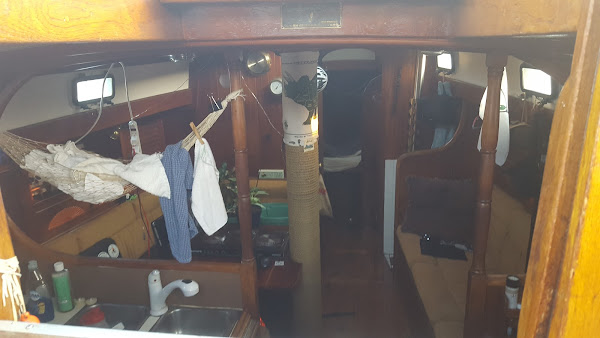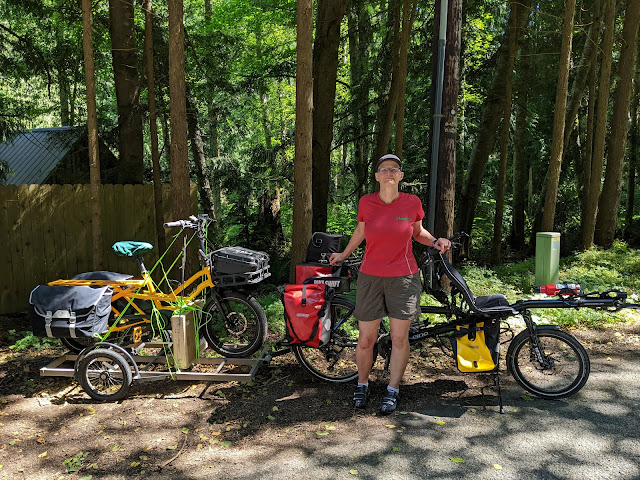Actual Engine Removal
Here's where things get interesting. This is Part 3 of our engine removal. Another way to preface this is: "If it ain't one thing, it's every other damned thing."
The gantry has proven itself well. It pulled everything thus far with no creaks or groans. Now to test lifting the engine! Here we are testing it all out. No groans or creaks. The gantry is solid and performing as expected.
Surprise!
And then... this.
 |
| Well. Shit. The crack doesn't look so bad because the engine has been put back down on the stringers. |
We overbuilt the gantry beam. Two 2x6 fir beams should have been sufficient, so of course we used two 2x8 beams through-bolted so they behave as one beam. It turns out that materials capacity tables can't take into account defective materials. One of the 2x8 beams snapped at a knot on the bottom of the board. Fortunately there was a second beam to take the load. We were able to ease the engine back down into place.
Breakage was sudden, surprise was shared by all, and profanity flowed freely.
The two people on the dock are career mechanical engineers with a very impressive set of experiences on large scale industrial and civil projects. They consulted, critiqued, and offered revisions to our gantry. The engineering knowledge between these two is encyclopedic. Their surprise says it all. Despite all of our comments in the video, the beams are actually 2x8.
This is what I get for buying lumber at a big box home improvement store. The failure originated at a knot on the bottom of the beam and spread through three other knots. We sifted through over a dozen boards to get the ones we had.
Some upgrade was needed to avoid risk of (additional) catastrophic failure. We switched to two Douglas fir 2x12, through-bolted. Excessive? You bet. This over-overbuilding was a very small cost compared to the cost of failure. Fortunately, the designs of the frame and legs allow for easy swap of the beam and increase in beam height.
This time we went to an actual local lumber store which had much higher quality wood. The staff picked out the lumber for us based on our stated usage, and they rejected only one board. By slotting the new beams into place one at a time, this was a very easy process. It took us longer to get the wood than it did to replace the broken beam.
To state that much more briefly: where you buy your lumber is important.
Even with steel bar stock on top of the beam, we decided that even less point loading would be better. Big Wrench returned with a friend; we put two large wrenches under the chain in order to further spread the load of the chain on the beam.
The map is not the territory
We started lifting the engine immediately after the wake from the last fast ferry subsided, about 8:10 PM. The engine came up with almost no issues, except there were a few wires I was unable to reach while it was still in the compartment. Snippity-snip.
 |
| Peekaboo. |
Churn
It wouldn't be a boat project without some snarl. I screwed up on my engine height measurements. First, I took the measurements out of the engine manual. This engine has a heavier, deeper oil pan, contributing to the overall height we need in order to clear the coamng. The gantry is not tall enough for the combined vertical height of the chainfall, hoist chains, and engine oil pan. I really should have measured the actual engine. We are eight inches too short.
A common saying in engineering is "Trust but verify."
 |
| Hmph. That's not going to fit. The engine is almost at maximum possible height here. |
The plan of sliding the hoist along the top of the beam was now shot. A new plan was required. In hindsight, there were at least five things I could have done differently. Instead of doing those things, I latched onto the idea that we would use a bunch of ratchet straps to lift the engine higher and "walk" it out by alternately lifting and easing the straps.
To add to our concerns, one of the A-frame legs started bowing outward in a very concerning fashion. Despite having the dock leg in place and the engine shifted towards the dock, the leg was still floating above the dock. The boat had yet to heel enough for the dock leg to start holding the load of the engine. If that A-frame leg snapped, we might have a momentary load that could exceed our design limits. If it happened while over the coaming, the coaming or winches could be seriously damaged. Even worse, if we cracked the oil pan, it would be more economical to scrap the engine.
We decided to reinforce the bowing frame leg with a 2x8 taken from the original beam. We cut the 2x8 to be an exact fit for that leg of the A-frame and through-bolted it to the leg. Trying bowing now, buddy!
An additional error in my calculations and execution was that we pumped out all of the diesel because of timing requirements of the person who wanted the fuel. The boat now sat higher in the water, so the dock leg floated even higher off the dock. The boat would have to heel farther before the dock leg was loaded. This would put stresses on the gantry for which I didn't account. The solution was to just shim the dock leg with ⅜ inch plywood. We heeled the boat away and slid the plywood under the dock leg.
 |
| It's late, we're tired, and we need more tools. |
By now, it was past midnight on an operation that should have been 45 minutes. We ran out of shackles, quick-links, and straps for continuing this operation. We secured the engine in the cockpit for the night. We set it down partially on the lazarette, partially on the coaming, and partially depending from the gantry. We also removed the shim under the dock leg so that it could float freely during the night. The fast ferry starts early and will rock the boat.
 |
| Good morning! Ready for some more? |
The next day ended up taking seven hours. Using ratchet straps, we lifted the engine with a set of straps set further out, then eased the straps. It's easier to show the process with a video.
It turns out that our final setup was plenty robust for all of the dynamics involved. Emily leaned against the boat to hold it taut against the dock lines. This reduced some of the motion, but there were still significant wakes during the day. To add to the motion, the wind picked up markedly and also rocked the boat.
I learned a new trick courtesy of Terry of Diver Down Yacht Service. By using three lines at the lift point of a hanging mass, large items can be precisely positioned. I wish I had a better picture of this in action. Terry uses this technique to singlehandedly install large propellers underwater. With Terry's help, we were able to easily lower the engine onto its cradle.
 |
| Victory! |
 |
| The engine is giving me the stink-eye for disturbing it. Your iron heart will beat again, buddy! |
What We Would Have Done Differently
Experience is what you get immediately after you needed it. In retrospect, there are things that would have eased the overall experience. We learned some lessons and also tested our hypotheses and skills.
Some things we would consider doing differently:
- Disassemble the engine in place. This is a tough one to say for sure either way. The Ford Lehman 21412E is a robust engine, designed to run 20,000 hours between major rebuilds. Our engine has only 1800 hours on it and it would be a terrible shame to scrap the engine.
- Build a more robust A-frame. The A-frame was designed to take half the load of the engine, and only during the initial lifting. We did end up reinforcing one of the legs, but it would have been better to start with a more robust A-frame, just for peace of mind.
- Check the lumber even more closely and any edge knots would have been placed on top. Actually, I would have bought my lumber from an actual lumber store, rather than a big box store. This would allow the knots to be used in compression rather than tension.
- Use a Laminated Veneer Lumber beam instead of dimensional lumber.
- Measuring the engine, rather than trusting the manual.
- Used a second gantry or lift on the dock. The single gantry was a lot of design and implementation. Passing the motor to a second gantry or even an engine lift on the dock would have eased timing concerns. This also would have resolved the problems with the boat, dock, and engine moving independently of each other.



Cray cray dude! Glad you persevered!!
ReplyDelete